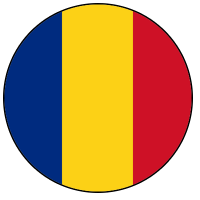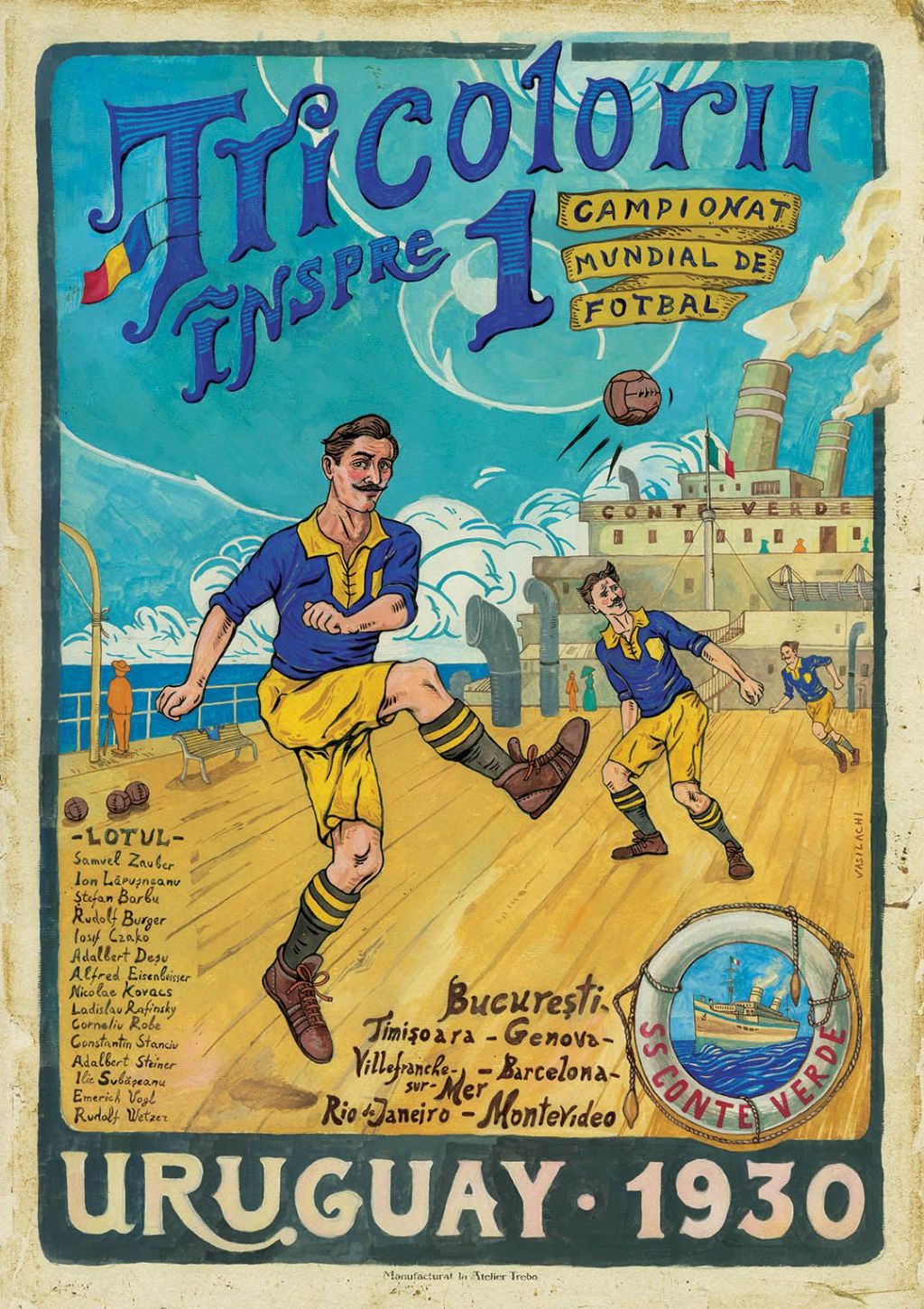The story continues. (See here for part 1 of this timely look back at something which happened almost exactly 89 years ago next-but-one month.)
The draw was made the following day. There were thirteen teams, one fewer than expected: the Egyptian delegation had missed their connecting ship after being held up by a storm in the Mediterranean. The hosts, Olympic football champions in 1924 and 1928, were strong favourites, and it was into their group that Romania were unlucky to be drawn. Wetzer said in reaction, “I have the sensation that someone has hit me over the head with a cudgel.” Romania’s other opponents, Peru, on the other hand, had had a national team only since 1927. Of their six official matches to date, they had lost five, including two heavy defeats against each of Uruguay and Argentina. Nevertheless, few back home in Romania expected their boys to get a result in their opening fixture against the Peruvians.
The game of their lives
The match between Peru and Romania, at Peñarol’s Estadio Pocitos on the afternoon of Monday 14 July, was witnessed by the smallest World Cup crowd of all time. The official attendance is given as 2,549, but at the time it was estimated at between three and five hundred. (If you thought it was tricky to untangle the truth from the myth in the build-up to the tournament, it gets even more difficult when it comes to the big game. Please excuse the frequent use of brackets…) Gate takings were 657 pesos, less than half what was taken at the only other match at Pocitos, France v Mexico.

Although they were by all accounts skilful and fast, the Peruvians’ strategy was, from the outset, to play very aggressively. Faced with tough tackling, the Romanians tried not to keep the ball for long. This meant no dribbling for the likes of Wetzer, while Raffinsky was trying to give his opponents a taste of their own medicine. But after just ten minutes of the game, Peruvian left-winger Luis de Souza (or possibly defender Mario de las Casas) went in hard on Adalbert Steiner, “jumping on him as if into a sand pit”, and broke the defender’s leg. The game, in which the Romanians had been on top, had to be suspended for ten minutes while Steiner was helped onto a stretcher.

With time ticking away, the scores were level. Then, as Wetzer put it, “a miracle occurred. Stanciu tore himself from the doctor’s grasp and re-appeared on the field, hobbling, as if he had an invisible crutch. When I saw him, I could not hold back the tears.”
Stanciu stood out wide on the right, and was ignored by the opposition. Then “a pass from Wetzer found Barbu on the left. A dribble and a low cross, towards nobody. But yes, there was somebody.”
Wetzer paints a picture of this essentially one-legged man, hobbling or hopping towards the ball. Valdivieso is as surprised to see him as if Stanciu were a ghost. He is even more surprised, as he dives at the ghost’s good leg, to see the ball fly past him into the net off the ghost’s bad leg, for a two-one lead! If this account seems fanciful, well, other reports, more prosaically, have Barbu down as the scorer. Regardless of the name on the scoresheet, this goal knocked the stuffing out of Peru and Covaci (or possibly Kovács… only kidding: they’re the same person) was able to put away a third goal at the death.

In just a week, they would be facing the favourites Uruguay. The squad spent their time training, going to the other matches, and visiting Steiner in hospital. Team manager Rădulescu, who was an experienced referee, ran the line for Argentina v France and Argentina v Mexico.

A class apart
The Centenário stadium was brand new, having been officially inaugurated at Uruguay’s first match of the tournament – a 1-0 win over Peru – a few days earlier, on the 100th anniversary of the adoption of the country’s first constitution. The stadium was much bigger than the Pocitos, and, on 21 July, full to the rafters with over 90,000 locals – roughly Timișoara’s entire population at the time. There is not much to say about the match itself, it seems. “The great skill of the light blues is that of the high-speed one-two. With those they had us beaten in six minutes,” wrote Wetzer. The Romanians defended brilliantly at times, but were four-nil down at the break. In the second half only one of the Uruguayan forward line, Iriarte, was really trying. The other four had already scored, and they weren’t minded to put much effort into helping him join them on the scoresheet. Romania troubled the hosts’ defence only once, when the Brazilian referee disallowed a goal, but neither did the Uruguayans add to their tally. The hosts would go on to win the championship, while the Romanians were out of the tournament. But they could not go home until the show was over – they were booked on a boat back for 30 July, the day of the final.
Embed from Getty ImagesAfter a hastily-arranged friendly against Racing, across the water in Buenos Aires, the Romanians popped back over the Río de la Plata to watch the World Cup final at the Centenário on final day to find a city gone nuts. The streets were full of people, including a lot of Argentines who had also crossed the river for the occasion.
“The streets are extremely crowded. There’s an indescribable hubbub. The Argentine supporters, draped in their blue and white flags, chant, “Argentina yes, Uruguay no”. The groups brawl. But we carry on. I think it was like this at Pompeii when the lava was flowing. And they’ve stopped the trams. It’s as if there’s no electricity. The traffic police have strategically left their positions.”
There are plenty of other places you can read about the parts of the tournament that did not involve Romanians. Dean Lockyer’s impressive 1930 World Cup Project is one of them, and Simon Burnton’s Guardian article is another (shorter) option. This here is a lovely photographic book. And there are many, many more fascinating stories. However, it’s time for us to leave the New World. Rudy Wetzer was of the opinion that the final itself was “the finest football match I have ever seen.” The man who refereed the final, Belgian John Langenus, had wisely arranged beforehand an armed escort to rush him to the port, so as to avoid angry mobs of fans. He and his compatriots joined the French, Yugoslavian and Romanian delegations on a voyage infinitely less reported than the outward trip.

On the journey home, Eisenbeisser came down with pneumonia and he had to be hospitalised upon arrival in Genoa. He reportedly lost 15 kilos in weight. Somehow the rumour that he had died en route was strong enough to persuade his family, in distant Bucovina, to arrange his funeral. Supposedly he turned up back home, alive and well, on the very morning of his own wake and his mother collapsed in a faint. You know what? That sounds ludicrous, but I’m tired of fact-checking.
In Bucharest, a crowd had again assembled to greet their heroes. “The trams have been stopped. Like in Montevideo. Everyone wants to see us,” relates the captain’s log. A Romanian football team had represented its young nation with honour on the other side of the world.
What happened next?
Steiner took a year to recover from his double fracture. No sooner had he returned to football than he sustained another break, of the same leg, in 1932 and was forced to retire, aged 24.
Eisenbeisser made a full recovery from pneumonia and won league titles with Venus București, alongside Lăpusneanu and Stanciu. He also competed for Romania as a figure skater in the 1936 Winter Olympics. However, the same illness forced Deșu to retire from playing in 1933, and he died of the illness aged just 28.
Romania participated in the next two World Cups, in 1934 and 1938, which both took place in Europe, but failed to win a match at the finals until 1970. Bürger and Kovács were among only five men who appeared at all three pre-war World Cups; Rădulescu was involved as trainer or manager at both tournaments. Deșu, Subășeanu and Czako never represented Romania again. Raffinsky played at the 1938 tournament; he and Barbu each have a place in Rapid Bucharest’s hall of fame thanks to their roles in the club’s successes immediately before the Second World War.
In the early 1930s, Luchide and Rădulescu were prime movers in changing the national football competition from a knockout tournament, contested by regional champions, to a divisional league format. The first edition of this unified national division was won by Bürger‘s Ripensia Timișoara team. Wetzer, player-coach during Ripensia’s first season in competition, went on to coach the newly-created Dinamo București after the war.
Lăpusneanu and Vogl each had a stint managing the national team in the 1940s; the latter worked for the federation, on and off, for much of the rest of his working life, his last involvement being as technical advisor to the Romania squad that qualified for Mexico 1970.
Sources
Ionescu, Mihai, & Mircea Tudoran (1984). Fotbal de la A la Z.
Flamaropol, Mihai (1986). Fotbal: cadran românesc.
Chirilă, Ioan (1986). Zile și nopți pe stadion.
worldcup1930project.blogspot.com
Tătaru, Ionuț (2014). Poveştile Cupei Mondiale. Prima victorie a României. antena3.ro
Druckeria. Drumul spre Mondial trecea prin Timișoara: Voiajul de pe Conte Verde – Uruguay 1930 druckeria.ro
Druckeria. Și Timișoara a fost pe Conte Verde. druckeria.ro
Biholari, Cornel (2019). Cel mai ghinionist timişorean de la Montevideo. pressalert.ro
Burnton, Simon (2018). World Cup stunning moments: the Conte Verde’s trip to Uruguay in 1930. theguardian.com
Canelo, Pedro (2010). El primer expulsado en la historia de los mundiales fue peruano. elcomercio.pe
Fifa (2013). Romania’s football-crazy king. fifa.com
García Medina, Miguel (2010). Aquel lejano primer mundial. elcomercio.pe
Lagunas, Aitor (2016). La odisea del Conte Verde. panenka.org
Perta, Alexandru (2017). Octav Luchide, dezvoltatorul fotbalului românesc la începuturile sale. revistadefotbal.wordpress.com






Leave a comment